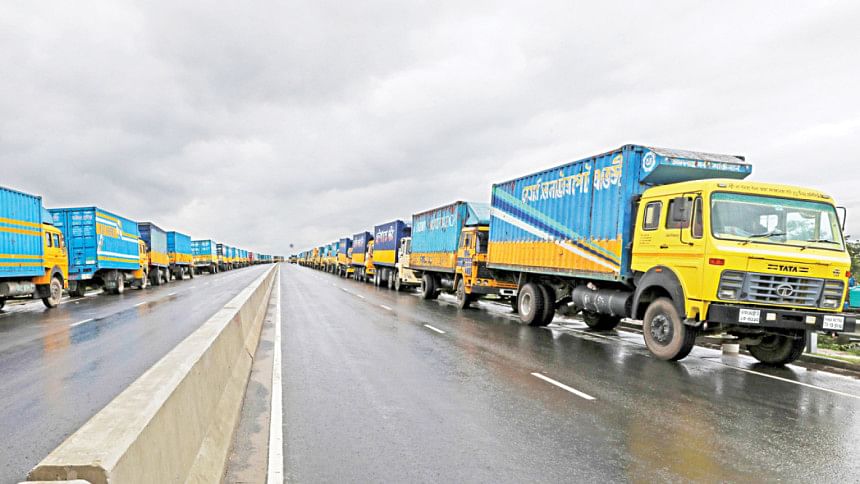Exporters brace for impact as India shuts cargo route

Exporters in Bangladesh's garment sector face a moment of reckoning over how they will manage urgent international shipments after India abruptly closed a transshipment route that had grown popular for air cargo.
The route, via Kolkata and Delhi airports, allowed Bangladeshi exporters to move goods overland to India through the Benapole-Petrapole border and then air-ship them worldwide. It became especially popular during and after the Covid-19 pandemic, offering faster service and, often, lower costs than relying on the overstretched Hazrat Shahjalal International Airport (HSIA) in Dhaka.
Industry estimates suggest about 18 percent of Bangladesh's garment air cargo was flown through Indian airports. Bangladesh exported roughly 3,400 tonnes of garments by air per week, with 600 tonnes flown through Indian airports before the transshipment ban, according to data from the Bangladesh Freight Forwarders Association.
The government has acknowledged airport challenges and says reforms are underway. Commerce Secretary Mahbubur Rahman said efforts were being made to reduce HSIA's ground handling costs and improve cargo services. Commerce Adviser Sk Bashir Uddin held meetings with relevant ministries yesterday to strengthen both Dhaka and Sylhet airports as viable export gateways.
A glimmer of hope lies in the third terminal at HSIA, which industry leaders say features modern scanning, testing, and temperature-controlled facilities. "The third terminal is the finest. It's just like the airport in Singapore," said Kabir Ahmed, president of the Bangladesh Freight Forwarders Association (BAFFA).
Still, the sudden Indian move has raised concern. "It does hamper potential, especially the intraregional potential," said Rubana Huq, former president of the Bangladesh Garment Manufacturers and Exporters Association (BGMEA). However, she said since Bangladesh has traditionally focused on direct shipping rather than transshipment, the immediate impact may not be severe.
Government officials echoed a similar tone. Mahbubur Rahman confirmed that cargo to Nepal and Bhutan via Bhomra land port remains unaffected by the Indian ban imposed on April 8. He added that Bangladesh will respond to the Indian decision diplomatically, while continuing domestic reforms to maintain export competitiveness.
Yet for many exporters, especially those serving fast-fashion clients with short lead times, the loss of Indian airport access is a blow. Now, increased shipments through HSIA are expected to stretch its already-burdened infrastructure. In some cases, suppliers will rely more on alternatives, including routing goods through the Maldives for onward shipping.
WHY EXPORTERS CHOSE INDIAN AIRPORTS
One of the main attractions of Indian air transshipment was the cost. While sending a kilogram of apparel from HSIA to Europe typically costs $2.90-$3.20 during off-peak periods (and up to $4.50 in peak season), shipping through India costs about $2.60 per kg, even after accounting for overland transport to Indian airports.
Major international buyers like Inditex (Zara's parent company), which maintains a distribution hub in Delhi, preferred this route for speed and efficiency. Local suppliers relied on it to shorten lead times and optimise delivery schedules.
By contrast, exporters have long complained about bottlenecks at HSIA. The airport's cargo village has a maximum capacity of 300 tonnes, but it handles over 800 tonnes daily even in the off-season, and up to 1,200 tonnes during peak periods. Ground handling inefficiencies and mismanagement have plagued the Dhaka airport for years. Shipments have reportedly been left exposed to the elements.
Ground handling fees are another sticking point. Dhaka charges 29 cents per kilogram compared to just five cents at Delhi airport. Combined with slower service and a lack of modern equipment, these high costs have driven exporters to seek alternatives abroad.
Fuel costs also play a role. A $1-per-gallon difference in jet fuel prices between Dhaka and Delhi gives Indian airports a further edge.
The airport cost is driven by the high price of jet fuel, which is about 30 percent higher in Dhaka than in India. "Jet fuel accounts for 40 percent of an airline's operating costs," Biman spokesperson Bushra Islam said.
"If that's the reality, then why wouldn't a businessman prefer Delhi over Dhaka for exporting cargo?" another Biman official said. "The government should seriously look into this."
"On average, 1.75 lakh tonnes of cargo are exported annually from Dhaka airport, and Biman carries 16 to 17 percent of that total," Bushra told The Daily Star. She added that Biman also provides ground-handling facilities to various airlines that transport this cargo.
Bushra, general manager (public relations) at Biman, said the airline's cargo handling capacity will double once the third terminal becomes operational. Currently, Terminals 1 and 2 have a combined space of 19,600 square metres dedicated to export-bound cargo, with an annual handling capacity of two lakh tonnes of goods. The new third terminal alone will offer 36,000 square metres of space for exporters, with a handling capacity of 5.46 lakh tonnes per year.
A senior cargo department official at Biman said several charges, such as overflying, landing, and parking fees, are imposed by the Civil Aviation Authority of Bangladesh (CAAB), not Biman. "We only provide ground handling services to foreign airlines," he said, requesting anonymity.
There are also infrastructure-related challenges. For instance, a cargo aircraft that exceeds the prescribed weight limit cannot land at Dhaka airport because of the runway's limited strength.
Additionally, Dhaka lacks world-class retail brand stores, which means there's little to no incoming cargo business. In contrast, when cargo aircraft land in India, they can bring in goods for stores in Delhi, Chennai, Mumbai, and other major cities, making the return trip economically viable.
"That's why the operating cost of cargo aircraft is lower in India -- they can carry goods both ways," he added.
The official said a meeting was held with Commerce Adviser Sk Bashir Uddin on Wednesday night to discuss ways to resolve the issue. "We hope for a positive outcome soon," said the official who attended the meeting, declining to give further details.
Unlike passenger services, the cargo business operates on a demand basis. When demand rises, exporters often charter freighter services, jointly deciding with importers how and where to send goods. When demand is low, airlines carry cargo in the belly of passenger aircraft.
Emirates, Cathay Pacific, Qatar Airways, Turkish Airlines, Ethiopian Airlines, and several other carriers currently operate dedicated cargo flights from Dhaka.
"We are opening Sylhet for cargo operations on the 27th of this month, and Chattogram will follow shortly," said Air Vice Marshal Monjur Kabir Bhuiyan, chairman of CAAB. "With the third terminal and its increased capacity, plus a fully automated system, we'll be able to handle our own cargo. That will also boost our revenue."


 For all latest news, follow The Daily Star's Google News channel.
For all latest news, follow The Daily Star's Google News channel. 






Comments